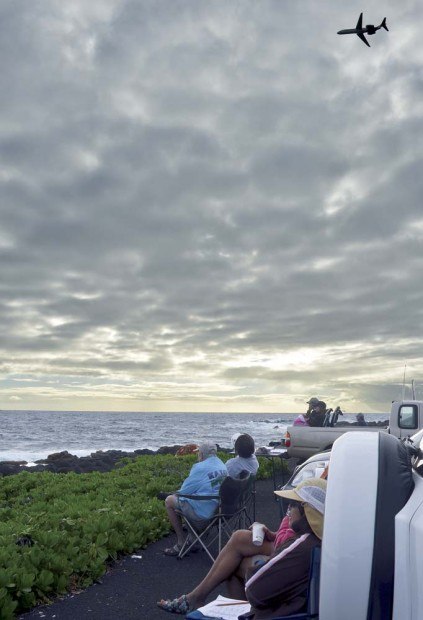LIHU‘E — Close to 200 volunteers turned out to participate in the Kaua‘i National Oceanic and Atmospheric Administration’s Hawaiian Islands Humpback Whale National Marine Sanctuary Ocean Count, last Saturday. Jean Souza, the Kaua‘i coordinator for HIHWNMS, said 191 volunteers helped
LIHU‘E — Close to 200 volunteers turned out to participate in the Kaua‘i National Oceanic and Atmospheric Administration’s Hawaiian Islands Humpback Whale National Marine Sanctuary Ocean Count, last Saturday.
Jean Souza, the Kaua‘i coordinator for HIHWNMS, said 191 volunteers helped at 15 sites around Kaua‘i and the site leaders, or naturalists, at 13 of the publicly accessible count sites educated 368 people who visited during the counts and needed information, or education about what the groups were doing.
Christine Brammer, communications coordinator for the HIHWNMS, said more than 900 volunteers collected data from the shores of O‘ahu, Kaua‘i and the Big Island for the annual Ocean Count, the first of three scheduled for 2011.
“Ocean Count participants tallied humpback whale sightings and documented the animals’ surface behavior during the annual survey,” Brammer said in an NOAA release. “Volunteers collected data from 62 sites statewide with an average of five whales counted per site every 15 minutes.”
The average number of whales sighted per 15-minute count period included four seen on O‘ahu, six sighted on Kaua‘i, and four sighted on the Big Island.
“With perfect weather conditions, a record number of volunteers statewide and a remarkable amount of whale activity, Saturday’s event was an exciting launch to the 2011 season,” said Claire Kavanaugh, the Sanctuary Ocean Count project coordinator, in the release. “The Ocean Count project provides a unique opportunity for the public to learn about Hawai‘i’s humpback whales while participating in a monitoring effort.”
Souza said, on Kaua‘i, weather conditions were excellent compared to January of last year when rain, wind, and foggy conditions hampered viewing. She noted that waves were reported to be a little choppy on the Eastside, but overall, weather conditions were very nice.
Kaua‘i’s busiest site was Crater Hill where 11 whales were sighted during the 15-minute count period. This compares with Kilauea Lighthouse where five whales were seen in the same count period.
Port Allen Cemetary averaged 10 whale sightings in the count period with Ninini Point in Nawiliwili and the Waimea Canyon Drive Overlook averaging eight sightings.
Mahaulepu-Haula and Kaiwa Point sites averaged seven whales in the count period.
Overall, the six-whale average compares with just two sightings during the 2010 count and eight whales counted during the 2009 count, the best activity since the count figures were recorded in 2005.
In addition to whale activity, ocean counters reported on Hawaiian monk seals, sea turtles, spinner dolphins and a variety of sea birds.
Brammer said scientific studies have shown that Hawai‘i’s humpback whale population has been increasing at an annual rate of approximately 7 percent.
“Over time, data from the Sanctuary Ocean Count can be used to corroborate these findings,” Brammer said. “Hawaiian waters provide critical breeding habitat for approximately two-thirds of the North Pacific stock of humpback whales.”
The sanctuary, which is managed by NOAA, protects humpback whales and their habitat in Hawaiian waters where they migrate each winter to mate, calve and nurse their young.
Registration for the second ocean count scheduled for Feb. 26 is currently being accepted. To register for counts on O‘ahu and the Big Island, visit sanctuarycount.org, or call 246-2860 to register for the Kaua‘i count.
A whale count on Maui is conducted independently by the Pacific Whale Foundation every February.



